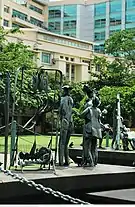Far Eastern University Institute of Technology
FEU Institute of Technology, also known simply as FEU Tech, is a coeducational, non-sectarian, private research university in Manila, Philippines. It offers courses in the fields of Engineering and Computer Studies. Established in 1992 as East Asia Computer Center, Inc.(EACCI), an educational partnership of Asia Pacific Computer Technology Center, Intelligent Wave Inc., and Far Eastern University.
 | |
Former name | East Asia Institute of Computer Technology (1992-1998) East Asia College of Information Technology (1998-2003) FEU – East Asia College (2003-2014) |
|---|---|
| Motto | Technology Driven by Innovation |
| Type | Trimestral, Private coeducational research university |
| Established | 1992 |
Academic affiliation | |
| President | Dr. Michael M. Alba |
| Senior Executive Director | Dr. Benson T. Tan |
| Location | P. Paredes St., Sampaloc, Manila , , 14.604141°N 120.988591°E |
| Campus | Urban |
| Hymn | The FEU Hymn by Nick Joaquin |
| Colors | Green and Gold |
| Mascot | iTamaraw |
| Website | feutech.edu.ph |
FEU Tech is an Institute of Technology. It is cited by the Commission on Higher Education as a Center of Development in IT Education (CoD).[1]
FEU Tech operates under the aegis of the Far Eastern University; it follows and is directly connected to the University. It is headed by Dr. Michael M. Alba as University President and Dr. Benson T. Tan as Senior Executive Director.
Like its sister schools, FEU Diliman and FEU Alabang, the college runs on a trimester academic system. An academic year starts in the second week of August and ends every June.
History
In 1936, the Institute of Technology was created in response to the increasing demand for trained engineers and technologists. It offered courses in architecture, engineering, and chemistry. Subsequently, after the Institute found itself squeezed between the government's cap on tuition fee increase and the rising costs of providing quality education in engineering, the administration decided to phase it out in favor of computer technology programs and had the Institute of Technology closed in 1996.[2]
Earlier, in July 1991, IBM Philippines together with SM Foundation, Inc. founded Asia Pacific Computer Technology Center (APCTC) in an effort to address the manpower needs of the growing Information Technology industry. APCTC later collaborated with the Far Eastern University (FEU) and Intelligent Wave, Inc. to set up a computer school, which was called East Asia Computer Center, Inc. (EACCI) Later, it was eventually renamed as East Asia Institute of Computer Technology.[2]
On September 30, 1998, the Commission on Higher Education (CHED) noted the change of its name to East Asia College of Information Technology (EACIT).[2]
On February 24, 2000, EACIT was identified by CHED as a Center of Development for Excellence in Information Technology Education.[1]
In 2001, EACIT sought the approval of CHED to offer additional courses leading to Bachelor of Science in Information Technology and Bachelor of Science in Information Management. In the same year, FEU reopened its College of Engineering offering a trimestral (four years and one term) program. Full recognition of the programs were approved in 2004.[2]
FEU bought out the shares of all incorporators and became the sole owner of EACIT in 2002. The following year, the College of Engineering was merged with EACIT and the two formed a technology education powerhouse known as FEU – East Asia College (FEU - EAC).[3]
In 2014, FEU - East Asia College was re-named back to its roots as FEU Institute of Technology.
Degree programs
FEU Tech has four programs with Level II accreditations from PAASCU: BS Computer Science with specialization in Software Engineering, BS Information Technology with specialization in Web and Mobile Application Development, BS Civil Engineering, and BS Computer Engineering.[4]
College of Computer Studies
- Bachelor of Science in Computer Science
- Specialization in Software Engineering
- Specialization in Business Analytics
- Bachelor of Science in Entertainment and Multimedia Computing
- Specialization in Digital Animation Technology
- Specialization in Game Development
- Bachelor of Science in Information Technology
- Specialization in Digital Arts
- Specialization in Animation and Game Development
- Specialization in Web and Mobile Applications
- Specialization in Service Management and Business Analytics
- Associate in Computer Technology
College of Engineering
- Bachelor of Science in Civil Engineering
- Bachelor of Science in Computer Engineering
- Bachelor of Science in Electrical Engineering
- Bachelor of Science in Electronics Engineering
- Bachelor of Science in Manufacturing Engineering
- Bachelor of Science in Mechanical Engineering
Department of Graduate Studies
- Master of Information Technology[5]
Buildings

FEU Tech occupied three major buildings in the FEU campus. These were the Main Building, Technology Building, and Annex Building (re-named as Admissions Building, Engineering Building, and Education Building respectively).
The current Engineering Building is the site of the former FEU hospital designed by Arch. Felipe Mendoza that was inaugurated on October 22, 1955.
In 2014, FEU Tech transferred to a newly constructed FEU Institute of Technology (FIT) Building, a 17-storey building located at P. Paredes St., a few meters away from the main campus. Main operations and classes are based in the FIT Building, with some still being held at the Engineering Building along Nicanor Reyes Sr., St.
FIT Building
- E-Library, Swimming Pool, Covered Gym and Basketball Court, Computer Labs, Electronic Labs, Academic Rooms, Chemistry and Physics Rooms.
Engineering Building
- Computer Labs, Electronics Labs, Data Center, Library, Academic Rooms, PE Rooms, FEU Foodcourt, Car Park, FEU Innovation Center
References
- https://ched.gov.ph/wp-content/uploads/2017/10/NCR.pdf
- "FEU Tech Student Handbook 2014 Edition". Issuu. Retrieved 2020-11-12.
- "About Us | Facts and History".
- "FEU Investor Relations". investors.feu.edu.ph. Retrieved 2021-01-12.
- INQUIRER.net (2014-05-23). "FEU Tech innovates technology education with new program and pioneering specializations". INQUIRER.net. Retrieved 2020-08-06.
